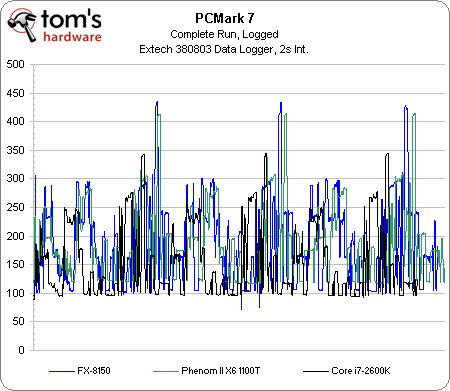AMD Bulldozer Review: FX-8150 Gets Tested
Perhaps the most hotly-anticipated launch in 2011, AMD’s FX processor line-up is finally ready for prime time. Does the company’s new Bulldozer architecture have what it takes to face Intel’s Sandy Bridge and usher in a new era of competition?
Power Consumption
According to AMD, the decisions its architects made when they designed Bulldozer centered on maximizing efficiency. In a big multi-chip module like Interlagos, squeezing the most performance out of every core under a hard thermal limit just makes good sense. The question is whether the same scalable design is as efficient on the desktop as it promises to be in the server space.
| Processor | System Idle Power |
|---|---|
| AMD FX-8150 (Zambezi) 8C/8T, 3.6 GHz Base | 107 W |
| AMD Phenom II X6 1100T (Thuban) 6C/6T, 3.3 GHz Base | 114 W |
| AMD Phenom II X4 980 BE (Deneb) 4C/4T, 3.7 GHz | 100 W |
| Intel Core i7-2600K (Sandy Bridge) 4C/8T, 3.4 GHz Base | 90 W |
| Intel Core i5-2500K (Sandy Bridge) 4C/4T, 3.3 GHz Base | 90 W |
| Intel Core i7-920 (Bloomfield) 4C/8T, 2.66 GHz Base | 130 W |
At idle, the system armed with AMD’s 125 W FX-8150 sips 107 W—less than the Phenom II X6 1100T, but just slightly more than the Phenom II X4 980 (both of which are also 125 W parts). Only Intel’s Bloomfield-based Core i7-920 consumes more (130 W system power).
In contrast, though, the two systems armed with Sandy Bridge-based parts drop to just 90 W (their 95 W TDPs are already 30 W under Zambezi’s thermal ceiling).

I pulled the Phenom II X4, Core i7-920, and Core i5-2500K runs off of this graph because they cluttered it up way too much. The three chips left are, in my opinion, the most relevant.
The black line corresponds to Intel’s 95 W Core i7-2600K, which averages 155 W system power use throughout a complete run of PCMark 7. Before you mention that the Core i5-2500K is closer, price-wise, to the FX-8150, know that it averages just two watts less than the -2600K, at 153 W across the entire run. Imagine that its plot would look almost identical.
The FX-8150, in comparison, averages 191 W. That 34 W delta almost exactly correlates to the 30 W separating Intel’s 95 W rating and AMD’s 125 W TDP. Even more interestingly, the Phenom II X6 1100T hits the same 191 W system average across PCMark 7. Meanwhile, the Phenom II X4 980 averages 184 W.
Intel’s Core i7-920 stands out as the one model to use more power than AMD’s new flagship. A 193 W average consumption number is 2 W higher, which we’d consider reasonable given a 5 W-higher TDP.
Stay On the Cutting Edge: Get the Tom's Hardware Newsletter
Get Tom's Hardware's best news and in-depth reviews, straight to your inbox.
Current page: Power Consumption
Prev Page Overclocking FX-8150 (On Air) Next Page Sneak Peek: AMD’s Bulldozer Architecture On Windows 8